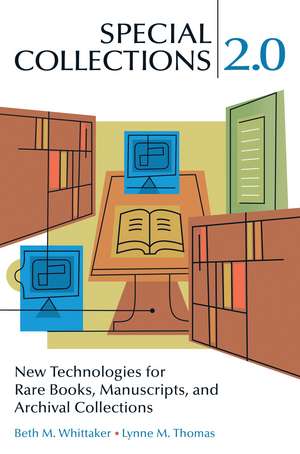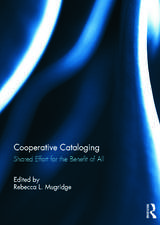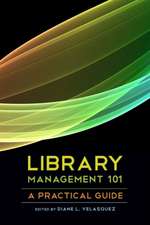Special Collections 2.0: New Technologies for Rare Books, Manuscripts, and Archival Collections
Autor Beth M. Whittaker, Lynne M. Thomasen Limba Engleză Paperback – 22 iul 2009 – vârsta până la 17 ani
Preț: 303.31 lei
Preț vechi: 372.74 lei
-19% Nou
Puncte Express: 455
Preț estimativ în valută:
58.04€ • 60.76$ • 48.02£
58.04€ • 60.76$ • 48.02£
Carte tipărită la comandă
Livrare economică 05-19 aprilie
Preluare comenzi: 021 569.72.76
Specificații
ISBN-13: 9781591587200
ISBN-10: 1591587204
Pagini: 176
Dimensiuni: 156 x 235 x 13 mm
Greutate: 0.28 kg
Ediția:New.
Editura: Bloomsbury Publishing
Colecția Libraries Unlimited
Locul publicării:New York, United States
ISBN-10: 1591587204
Pagini: 176
Dimensiuni: 156 x 235 x 13 mm
Greutate: 0.28 kg
Ediția:New.
Editura: Bloomsbury Publishing
Colecția Libraries Unlimited
Locul publicării:New York, United States
Caracteristici
Separate chapters on the new tools of Web 2.0, including wikis, blogs, photosharing, and different social networks
Notă biografică
Beth M. Whittaker, MA, MLIS, is associate professor and head of special collections cataloging at The Ohio State University Libraries in Columbus, OH. Lynne M. Thomas, MS, MA, is head of the Rare Book & Manuscript Library and Juanita J. and Robert E. Simpson Rare Book and Manuscript Professor at University of Illinois at Urbana-Champaign.
Recenzii
This is a valuable introduction to any library with special or cultural heritage collections seeking to reach out to users via these new technologies.
Of all library programs, the Special Collections department might seem the least likely to jump onto the 2.0 bandwagon. Not so says Beth M. Whittaker and Lynne M. Thomas in Special Collections. . . . They conducted a survey among 'cultural heritage professionals' and discovered that, despite concern that new technologies are a distraction, many in the field are already finding ways in which Web 2.0 supports the traditional mission to collect and preserve.
This is not a how-to manual for working with digital records but instead provides a good conceptual overview of the impact these applications have on special collections. Whittaker and Thomas partner here to promote the use of Web 2.0 applications and technologies within the cultural heritage communities of libraries, archives, and museums. The work provides insight on and examples of how institutions can use a wide variety of 2.0 applications for internal work processes and to promote their collections to a wider public. Chapters devoted to the opportunities and challenges these technologies present to collection description and access, preservation, copyright, and use are particularly thought-provoking. . . . Verdict: Recommended as professional literature for special collections professionals.
Whittaker and Thomas present collection and archives professionals with an examination of the use of Web 2.0 applications and related technologies in the creation, promotion, and management of special collections resources,particularly as a strategy for reaching new audiences. The text incorporates findings from 300-plus responses to a survey gauging the knowledge of and interest in Web 2.0 applications among cultural heritage professionals. The authors discuss the use of specific applications-wikis, blogs, social networking, photo-sharing sites-as a gateway to special collections material, and examine how these technologies may affect digitization projects, preservation of born-digital materials, and funding agency response.
well-organised and engaging book will have serious credibility with specialised practitioners.
Of all library programs, the Special Collections department might seem the least likely to jump onto the 2.0 bandwagon. Not so says Beth M. Whittaker and Lynne M. Thomas in Special Collections. . . . They conducted a survey among 'cultural heritage professionals' and discovered that, despite concern that new technologies are a distraction, many in the field are already finding ways in which Web 2.0 supports the traditional mission to collect and preserve.
This is not a how-to manual for working with digital records but instead provides a good conceptual overview of the impact these applications have on special collections. Whittaker and Thomas partner here to promote the use of Web 2.0 applications and technologies within the cultural heritage communities of libraries, archives, and museums. The work provides insight on and examples of how institutions can use a wide variety of 2.0 applications for internal work processes and to promote their collections to a wider public. Chapters devoted to the opportunities and challenges these technologies present to collection description and access, preservation, copyright, and use are particularly thought-provoking. . . . Verdict: Recommended as professional literature for special collections professionals.
Whittaker and Thomas present collection and archives professionals with an examination of the use of Web 2.0 applications and related technologies in the creation, promotion, and management of special collections resources,particularly as a strategy for reaching new audiences. The text incorporates findings from 300-plus responses to a survey gauging the knowledge of and interest in Web 2.0 applications among cultural heritage professionals. The authors discuss the use of specific applications-wikis, blogs, social networking, photo-sharing sites-as a gateway to special collections material, and examine how these technologies may affect digitization projects, preservation of born-digital materials, and funding agency response.
well-organised and engaging book will have serious credibility with specialised practitioners.









